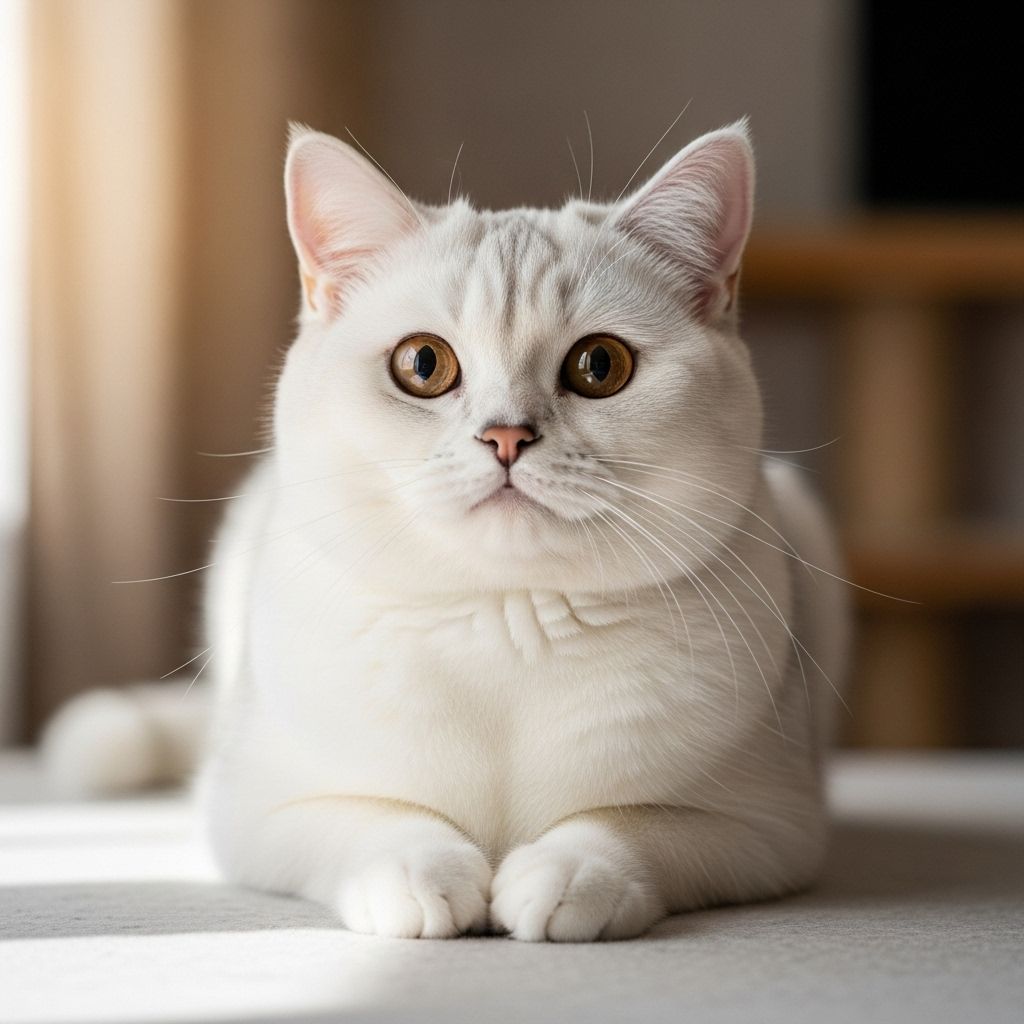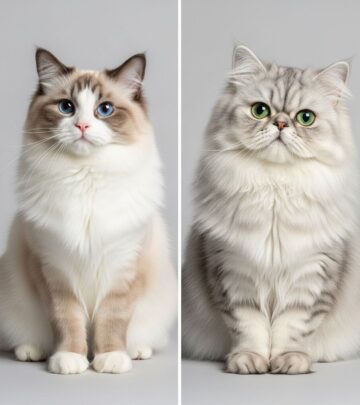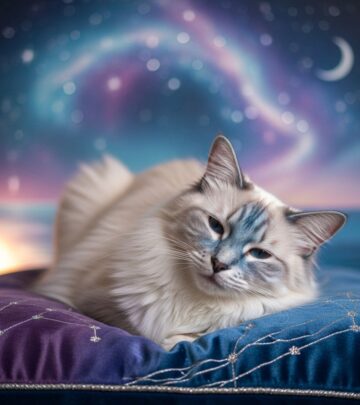White British Shorthair Cat: Personality, Care, and Breed Guide
Explore the calm charm and loyal nature of the white British Shorthair cat—an ideal companion for families and individuals alike.

White British Shorthair Cat: Personality, Appearance, and Care Guide
The white British Shorthair cat is a classic feline breed celebrated for its plush looks, gentle demeanor, and unwavering loyalty. As one of the most beloved cat breeds worldwide, this guide explores all that makes the white British Shorthair a remarkable companion—covering its origins, appearance, personality, living needs, and more. Whether you’re considering adopting or simply curious, discover everything about this charming and dignified breed.
Breed Overview
| Breed Name | British Shorthair |
|---|---|
| Origin | United Kingdom |
| Coat Color | White (and a variety of other colors) |
| Personality | Calm, loyal, independent, affectionate |
| Lifespan | 12–18 years |
| Good with Children and Pets | Yes |
| Activity Level | Low to moderate |
History & Origins of the White British Shorthair
The British Shorthair traces its roots to cats brought to the United Kingdom by the Romans, who sought skilled vermin catchers for their barns and homes. Over centuries, these cats developed into a solid, stocky breed with a reputation for both beauty and resilience. The white British Shorthair shares the same heritage as its blue and colored relatives, gaining distinct recognition thanks to its pure, striking white coat.
Historically, these cats have been favored for their adaptability and companionship, with popular culture appearances including the “Cheshire Cat” in Alice in Wonderland and “Puss in Boots,” adding to their fame and timeless appeal.
Appearance and Distinctive Features
- Body Structure: Muscular, broad-chested, and powerfully built—these cats showcase a well-balanced, robust physique with short to medium, strong legs and rounded paws.
- Head: The head is distinctly round with full cheeks, a firm chin, and large, expressive round eyes. Ears are medium-sized and set widely apart, adding to the breed’s “teddy bear” look.
- Coat: The coat is dense, plush, and short, forming a soft yet slightly resilient texture. Seasonal changes will see the coat becoming thicker in winter, providing natural protection.
- Color: While the British Shorthair is most iconic in “blue” (grey), the white variety stands out for its snowy, immaculate coat and striking eye color—which may be gold, copper, blue, or one of each (odd-eyed).
The overall impression is one of roundness and plushness, a look that’s both dignified and endearing—qualities that have cemented the British Shorthair’s popularity for centuries.
Personality and Temperament
The white British Shorthair is well-known for its calm and easygoing temperament. These cats tend to be friendly, affectionate, and non-aggressive, adapting well to households with other pets or children provided they are treated with respect.
- Placid and Patient: They prefer lounging over energetic play and are content to observe the world calmly, making them ideal for quieter family environments.
- Loyal and Loving: Once bonded, British Shorthairs are fiercely loyal, attaching themselves not just to individuals but entire families. They quietly follow their favorite people and enjoy being nearby without demanding attention.
- Dignified Independence: These cats value their autonomy. While they love affection, they decide when and how they receive it. They typically dislike being picked up or carried for long periods, especially by younger children, and prefer to keep their feet firmly on the ground.
- Adaptability: British Shorthairs handle change and new situations well. Their temperament remains consistent, making them great for first-time cat parents or busy families.
- Moderate Playfulness: As kittens, British Shorthairs are playful, but their energy gradually lessens as they mature. Adults enjoy toys and interactive games but are not hyperactive, destructive, or needy.
This unique balance of affectionate loyalty and dignified independence defines the British Shorthair’s enduring charm.
Living with a White British Shorthair Cat
British Shorthairs are low-maintenance and adaptable companions who fit easily into varied households. However, their unique needs and quirks deserve consideration:
- Attention Needs: Although these cats don’t require constant attention, they thrive when they receive affection on their own terms. They often watch their owners from a distance and come close when they desire interaction.
- Handling: Most British Shorthairs dislike being picked up or excessively cuddled, preferring instead to sit beside or near their family members. Gentle, respectful interaction fosters trust and ensures a harmonious relationship.
- Coexistence: Thanks to their calm disposition, white British Shorthair cats generally coexist well with other pets and children, provided introductions are handled patiently and respectfully.
- Independence: Their independent nature means these cats handle time alone well, without suffering from separation anxiety. Short absences by owners cause little distress, making the breed suitable for individuals with busy lifestyles.
Care, Grooming, and Health
White British Shorthairs benefit from a simple but consistent care routine, ensuring their health, happiness, and beautiful coats.
- Grooming: Weekly brushing is generally sufficient for the short, dense coat, although more frequent grooming during shedding seasons helps remove loose hairs and minimize shedding around the home. Regular eye and ear cleaning are equally important, especially for white cats who may show tear staining more prominently than darker counterparts.
- Nutrition: Their strong, broad build means British Shorthairs can gain weight easily. Owners should monitor diet, avoid overfeeding, and encourage moderate exercise. High-quality food formulated for their age and activity level will support optimal health.
- Exercise: Though not high-energy, the breed benefits from daily play—laser toys, towers, or even simple chase games—to keep muscles toned and prevent obesity.
- Health Considerations: British Shorthairs are generally robust and long-lived, but can be prone to certain conditions such as hypertrophic cardiomyopathy (a heart condition), obesity, and, occasionally, dental problems. Regular veterinary check-ups are essential for early detection and management.
White British Shorthair: Kitten vs. Adult
Kittens are notably energetic, curious, and playful. However, British Shorthairs mature slowly and take about 3–5 years to reach their full size and demeanor. As they grow older:
- Kittens become calmer, developing the dignified and laid-back attitude characteristic of the breed.
- The adult’s round head, prominent cheeks, and plush coat fully develop, giving them their “teddy bear” look.
- Personality becomes more predictable, with less mischief and more tranquility.
The gentle transition from kittenhood to adulthood makes the breed ideal for those seeking a stable and affectionate companion for the long term.
Famous British Shorthair Cats in Popular Culture
- Cheshire Cat (Alice in Wonderland): The smiling, enigmatic cat is based on the British Shorthair’s iconic round features and mysterious yet approachable nature.
- Puss in Boots: The clever, resourceful feline of storybook fame is thought to draw inspiration from the breed’s distinctive looks and dignified presence.
These appearances have further popularized the breed’s image as an emblem of both British literary culture and household companionship.
Is the White British Shorthair a Good Pet?
The white British Shorthair excels as a companion for those seeking a calm, low-maintenance pet with an affectionate but independent personality.
- Ideal for Families: Their tolerant nature makes them great with children and other pets.
- Low Demands: They do not require excessive attention or constant playtime.
- Perfect for Singles and Busy Owners: They enjoy company but cope well with solitude.
- Suits Apartments and Houses: Their moderate energy means they thrive in spaces large or small, with or without outdoor access.
Provided their calm dignity is respected, the white British Shorthair rewards owners with steadfast companionship, elegant beauty, and reliability—a combination that has won the hearts of cat lovers for generations.
Frequently Asked Questions (FAQs)
Q: Do white British Shorthair cats get along with children and other pets?
A: Yes, British Shorthairs are known for their tolerant, easygoing nature and can adapt well to families with children or other pets. Supervision and respectful handling are essential, especially with young children.
Q: Are white British Shorthairs hypoallergenic?
A: No, British Shorthair cats are not hypoallergenic. Despite their plush, short coat, they still shed dander and hair, which can trigger allergies in sensitive individuals.
Q: How much grooming do white British Shorthairs require?
A: Their dense, short coat needs weekly brushing to keep it smooth and reduce shedding. Extra grooming might be helpful during periods of heavy seasonal shedding or for white coats prone to staining.
Q: Can I leave my white British Shorthair alone while at work?
A: Yes, this breed tolerates alone time well due to its independent streak. Having toys or safe windows to observe the outdoors can help provide stimulation while you’re away.
Q: What should I know before adopting a white British Shorthair?
A: Ensure you can offer a calm, respectful environment, regular care, a nutritious diet, and gentle interaction that honors their need for independence. Early socialization and routine veterinary care will help ensure a healthy, happy pet.
Conclusion
The white British Shorthair cat is a treasured breed for those seeking an undemanding yet affectionate pet with aristocratic charm. They combine calm patience with enduring loyalty, making them a top choice for families and individuals alike. Whether you are seeking a serene companion or a plush feline to grace your home, the white British Shorthair’s grace and personality are sure to delight for years to come.
Read full bio of medha deb












